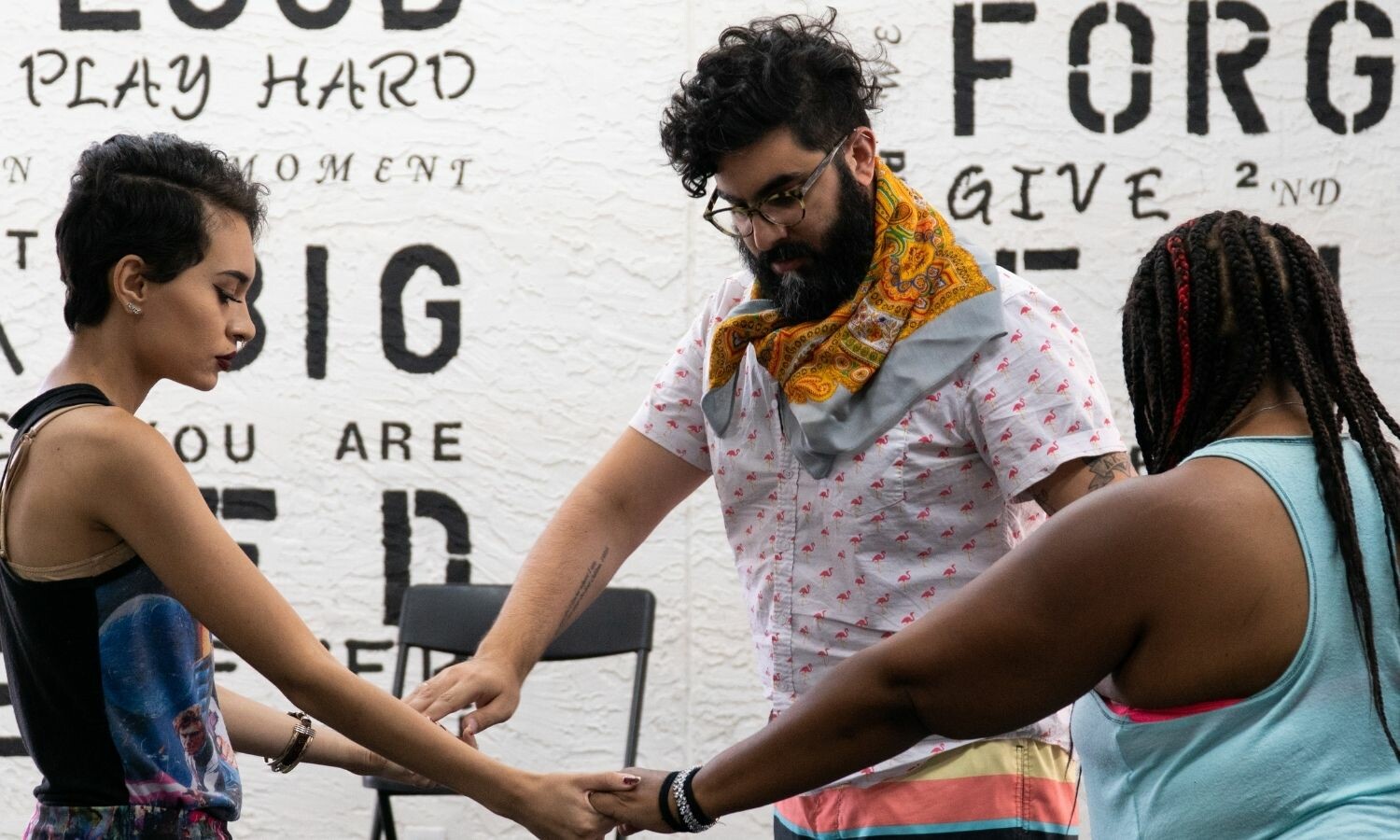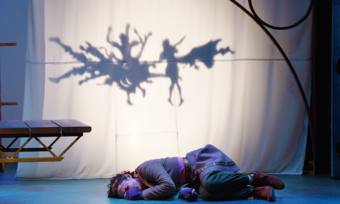As the founder of a trauma-informed arts organization who creates original work on social emotional well-being, I’m constantly thinking about how stress, trauma, and burnout may show up in individuals, the creative process, the organization, and myself throughout a production period. Over the past several years, I’ve focused my research on understanding how trauma, nervous-system responses, and creativity intersect. In response to the pandemic, I’ve noticed an increase in conversations about trauma and a desire to create performances as a way to process lived experiences.
Below I will share the considerations that guide my decision-making when aiming to mitigate stress, trauma, and burnout throughout a season. That said, please take care of yourself while digging into this essay. I will not explicitly describe acts that may be categorized as traumatic, but it is impossible for me to know what may activate/trigger you, so please put yourself first. Walk away if/when you need to; the essay will be here if/when you’re ready to return.
Basics of Working from a Trauma-Informed Lens
Historical trauma expert Iya Affo states that being trauma-informed means being able to say, “I see you, I’m interested in meeting your needs or yielding to your needs.” In an arts organization, it is allowing space for humanity to show up in the creative process, in our organizations, and in ourselves.
An important aspect of trauma-informed creative practices is understanding that trauma and creativity may not mix well. Creative humans may be curious, seek new experiences, engage in play, collaborate, be comfortable with ambiguity, and take risks. Humans with a history of trauma may not trust their intuition, may not believe in their creativity, may not have the capacity for imagination, and may seek out predictable and known patterns or situations. With this in mind, trauma-informed creative practices provide a rigid and predictable framework with fluidity in each stage. This allows individuals to build self-efficacy in the creative process in an effort to mitigate any trauma or stress responses that individuals may generate or have stored in their bodies.
Trauma is not an event. Trauma is a response that overwhelms an individual’s ability to cope. It throws our autonomic nervous system off-balance. When I’m talking about trauma, I’m mostly talking about little “t” traumas—not the headliner-type events that may come to mind, like mass shootings, rape, and violence, but the smaller, chronic ones, like microaggressions, teasing, and living through eighteen-plus months of a pandemic. These are things that may not seem like a big deal in the moment but can build up over time due to the chronic nature of the seemingly small responses. Little “t” traumas are the sneaky kind of traumas that we don’t realize are happening and therefore go unprocessed. This is one reason I often discuss stress, trauma, and burnout together. All three can cause our nervous system to be out of balance and therefore tip us into more of a survival state.
As the founder of Grey Box Collective, a trauma-informed, interdisciplinary, experimental, post-dramatic arts organization in the metro area of Phoenix, Arizona who devises performances on topics that are often difficult to discuss, I approach my work with a trauma-informed lens. I understand the nature of trauma in our nervous system, how it can present itself in a space of creativity, and how to shape those spaces to reduce perpetuating trauma or re-traumatizing someone. I have studied counseling, researched and created performances around topics of trauma for fourteen years, and am a certified trauma support specialist. I am not a licensed mental health professional. I say this to name the boundaries of my scope of practice.
I do not discuss trauma through a lens of pathology, I prefer the wider definition stated above. I also prefer a wider definition of “triggers” and prefer to discuss “activation” of the nervous system as it pairs well with a wider definition of trauma. I think of triggers as a light switch: if someone is triggered, they are instantly in a survival mode, having gone from zero to ten in an instant and without warning. I prefer to think of activation of the nervous system and visualize it as a dimmer switch. In understanding activation of the nervous system, the hope is to notice when we’re on the journey to a ten and be able to catch that activation around a three or four.
Most of the above philosophies have been informed by polyvagal theory, which has helped me understand stress, trauma, and burnout in myself and others. I find this theory along with a compassionate approach to learning from it has served me best in sustainable leadership of an arts organization, especially through a pandemic.
Trauma is not an event. Trauma is a response that overwhelms an individual’s ability to cope.
Considerations for Arts Leaders Preparing for In-person Performances
As we emerge from the pandemic, I am personally practicing and encouraging others to slow down, pause, or maybe even stop fully before starting any new projects to take the time to consider how stress, trauma, and burnout may show up in individuals, organizations, and ourselves throughout a production period in new ways. Here are some considerations for implementing trauma-informed work in the creative process, performances, and organizations.
The Tough Conversations About Trauma Start Internally
An organization is only as healthy as the mind, body, and spirit of its leadership. For those of us in positions of power, that means understanding our personal trauma histories, our scope of practice, our boundaries, and the power we hold. While we may feel we have a firm grasp of this, with the constant changes happening regarding the pandemic that require more nuanced decision-making, we might need to schedule more time to take care of our mind, body, and spirit.
Being in a position of power in an arts organization means recognizing the power we hold and being cognizant of the why behind the way we work with that power. Where there is someone in a position of power, there is someone, or multiple people, experiencing less agency. When an individual loses agency, it can be replaced with stress, which is where trauma responses may show up. Chronic stress in an organization could also lead to burnout and/or trauma in some cases. Being in a position of power means acknowledging that we can do our best but that stress, trauma, and/or burnout may still happen as a result of the structures, policies, and practices we chose to follow. This is something we have to be ready for. It’s not a hypervigilant sort of readiness but a confident readiness where we can have the resources to be responsive, integrity in our choice-making, and ultimately trust in ourselves.
It is essential that we work on ensuring we can be grounded, centered, and in the present moment throughout our role—especially where stress, trauma, and burnout may show up in ourselves or others. We must have the tools to regulate ourselves in the moment and process/discharge any activations we experienced at an appropriate time. This includes understanding when our nervous systems tend to become activated and developing sustainable coping strategies. Our pre-production work needs to begin in the areas we are finding ourselves activated. All that said, we are human. We may discharge our activation at inappropriate times. And we can repair any ruptured relationships that happen as a result of that. Activation is valid and is an indicator of where work begins so we can be effective and impactful leaders who strengthen the organization as a whole.












Comments
The article is just the start of the conversation—we want to know what you think about this subject, too! HowlRound is a space for knowledge-sharing, and we welcome spirited, thoughtful, and on-topic dialogue. Find our full comments policy here